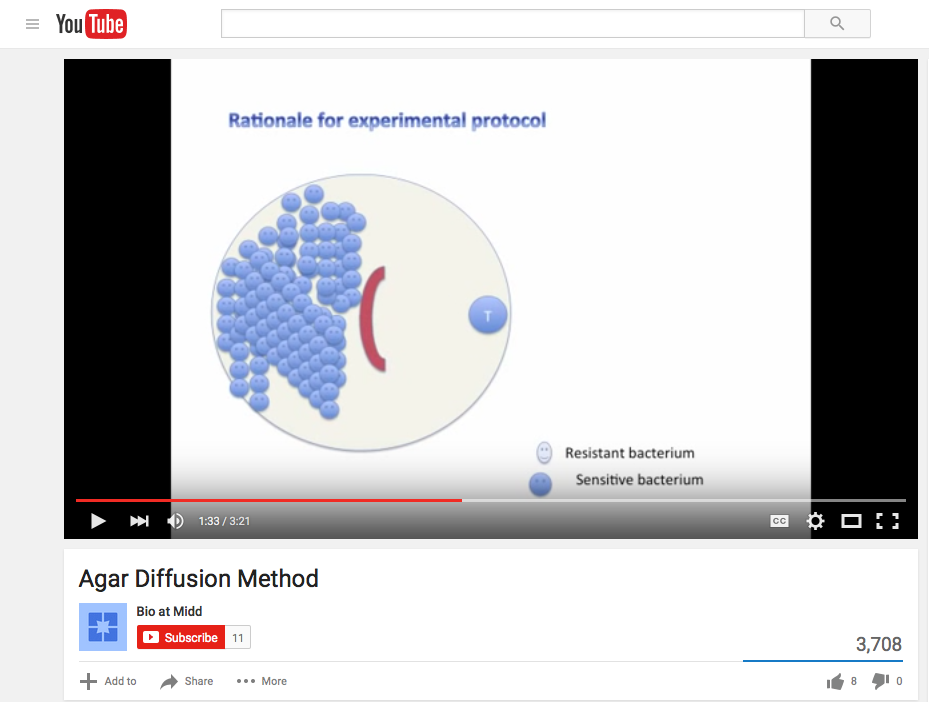By: Vickie Backus, Senior Associate in Science Instruction in Biology
The Challenge: Teaching How Natural Selection Leads to Evolution
I teach introductory biology to a diverse population of students. One of the key concepts that I teach is how natural selection can lead to evolution (defined as a change in allele frequency in a population). We model this using the real life problem of how bacteria can become antibiotic resistant due to chronic low dose exposure. The experimental technique that we use is a modification of the Kirby Bauer agar diffusion test where we load an antibiotic onto a filter paper disc and then place that loaded disc onto a bacterial lawn. Over 24 hours of incubation the antibiotic diffuses into the agar and sets up a concentration gradient. Bacteria with the alleles that have made them resistant to the antibiotic can live at higher concentrations than those that have alleles that make them sensitive to the drug and thus they can live closer to the filter paper disc (where the drug is more concentrated). This is seen as a clear ring (an area with no bacteria) around the disc that is called the zone of inhibition (ZOI). We found subsequent populations based on the bacteria’s ability to live at high concentrations of the antibiotic. You know that selection has increased the frequency of resistance alleles in the bacterial population when the radius of the ZOI decreases (which means that bacteria can live at higher concentrations than they have in the past.
Visualization leads to understanding
The method is simple to do but hard to understand because you can’t see the antibiotic in the agar (and can’t see the bacteria on the plate until you culture them). Thus some students have hard time visualizing what is happening and how the variable we measure (a decrease in the radius ZOI over time) is related to an increase in the resistance alleles in the bacteria population. The animation of the this process showing bacteria with the sensitive genotype, bacteria with the resistant genotype and toxin levels on the plate helps them to visualize this process and show how the relative proportions of the two types of bacteria (resistant and sensitive) change over time.
The Initial Animation
My first animation was a crude one made using Microsoft Powerpoint. While it worked it was clunky and the program was very limited in the tools that it had to make an animation. It was especially difficult to show how a concentration gradient of the antibiotic was set up; instead the tools showed the concentration as either high or zero, which is not correct and would not result in a selective response.
And the 2nd Draft
I was lucky that digital media tutor Katrina Moore ‘17 was interested in learning computer animation and was able to take on the job. We worked together to use Adobe Premiere to make an animation that was biologically realistic. We are finishing that process in January of 2016 and I will be able to use the final animation in Spring 2016. The way I will use it is to make it available on the class’s Moodle site by embedding it from MiddMedia and having the students watch it prior to class. I will evaluate their understanding of the technique by either having it be one of the topics covered in a prelab quiz or using it as a prompt for a think, pair, share exercise in class. I could have the students write their own narration for the video based on their understanding of the method that we are using. Small groups (lab partnerships for example) could view the completed video twice while given the opportunity to take notes. They then could use Quicktime to record their own version of the narration and submit the sound files via Moodle for assessment and comment.
[middmedia cd6868ebca83648aedf8ca834ba11026 DigitalMediaTutors agar_diffusion.mp4 width:800 height:600]
The initial video was well received by the students (even if it was a bit misleading) and lead to greater understanding of the method. Students were able to write and talk about the method in class in a deeper and more meaningful way after I started using it in my pre-lab lecture. It has been viewed over 3,000 times since it was posted to YouTube in February 2014; clearly it has appeal to learners beyond the College.
